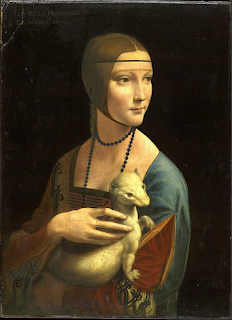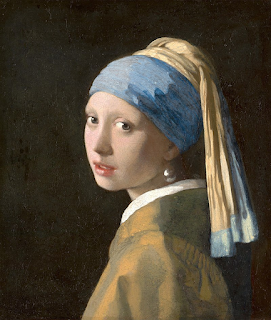Renaissance Art Analysis of Leonardo Da Vinci’s Lady with an Ermine
Renaissance Art Analysis of Leonardo Da Vinci’s Lady with an Ermine
Most anyone who has studied art
even to the slightest degree is familiar with the name Leonardo Da Vinci. An
artist, inventor, and scientist Da Vinci is one of the world's best-known
artists. Indeed, one of his paintings the Mona Lisa is one of if not the most
famous paintings in the world. This fact means that some of his other works are
overshadowed by this masterpiece.
Da Vinci moved to Castle Sforza in
Milan Italy in 1482 to work as a court painter for the Duke of Milan, Ludovico
Sforza. During his 16 years stay in Milan, sometime between 1489 and 1490 Da
Vinci created Lady with an Ermine (Winners). Lady with
an Ermine is a 40.3 cm by 54.8 cm oil painting on a walnut wood board
created for the Duke of Milan of one of his favorite mistresses Cecilia
Gallerani (Lady). While living in Milan he also created The Madonna on
the Rocks which is one of only four remaining paintings of women
created by Da Vinci and where he developed the contrapposto pose exhibited by
both the lady and the ermine in Lady with an Ermine in this
beautiful oil painting (Winner).
The use of oil paints for an entire
image boomed during the Renaissance. Because of this, images such as
this were able to be created that have incredibly soft blends and a glowing
quality to them. Gallerani is depicted in relatively simple clothes for a woman
of the court as she was from a large but non-aristocratic family. Lady
with an Ermine went through three major revisions while Da Vinci was
working on the image. His first version of the painting featured Cecilia Gallerani alone, the second included a small grey
ermine and the final version included the large white ermine that we see now
(Muñoz-Alonso). The ermine in the painting is meant to represent the Duke of
Milan in this portrait as his nickname was “the white ermine” and he could not
be featured in a portrait with his lover as he was married to Beatrice d'Este
(Muñoz-Alonso). Several aspects of this painting have been changed not only by
Da Vinci but also by other artists throughout time. Over time artists have
completely covered a door that used to be in the background and a transparent
veil worn by the woman was changed to the same color as her hair giving her
hair an odd curving under her chin appearance (Lady).
This painting, along with all of Da
Vinci’s other major works, were only able to come to fruition because of his
first patron, the Medici Family (Doll). This highly influential family helped
to shape much of the Renaissance in Florence through their patronage of the
arts. The family clearly had an eye for potential as they sponsored some of the
greatest artists of the Renaissance. It was because of the work that
he accomplished under the Medici’s patronage that Da Vinci was later accepted
as a court painter for the Duke of Milan Ludovico Sforza and later King Francis
I of France (Doll).
I enjoy this painting for several
reasons. To start, Gallerani is posed beautifully with exquisite rendering done
on the fabric of her dress that makes the entire image feel more lifelike.
Although not originally intended to be so dark, I quite like the harsh contrast
between the lady and the background. The lighting of this piece along with
Gallerani’s pose and expression give this painting a feeling of longing and
thinly veiled sadness. This makes sense given that this painting is essentially
a love letter to Gallerani’s married partner. The only aspect of the painting
that I don’t enjoy is the fact that the lady's once transparent veil has been
painted over to create a rather odd hairstyle. This does however help add to
the painting’s distinction. The most distinguishing, and my favorite element of
this painting is the large white ermine held by the woman. I enjoy this
component so much because it is sometimes difficult to find mostly accurate
depictions of animals in historical work (even this one is too muscular in
its' arms) or to have rodents depicted at all. For all these reasons and the
story behind this piece, I find this painting very appealing and would love to
recreate it with my own twists one day. While I can’t relate to the image's
backstory of being created for a duke’s affair partner, I can relate to wanting
to have a lovely high-quality painting of a rodent, even if that is not the
image's intent, and I still greatly enjoy the image.
On an added note, I found a source
that also suggested that the lady was holding the ermine in such a way as to disguise
her pregnancy. I could not link this full article because it was blocked to subscribers
but wanted to include the info as some bonus information.
Work Cited
Doll, Katie. “Leonardo da Vinci’s Patrons: Who Paid for His Art,” SHORTFORM, September 6, 2022, https://www.shortform.com/blog/leonardo-da-vinci-patrons/#:~:text=Leonardo%20da%20Vinci's%20first%20patron%20was%20the%20Medici%20family.,others%20in%20securing%20that%20patronage. Accessed 19, February 2023.
“Lady with an
Ermine - by Leonardo Da Vinci,” Leonardo Da Vinci, https://www.leonardodavinci.net/lady-with-an-ermine.jsp.
Accessed 19, February 2023.
Muñoz-Alonso, Lorena.
“Secrets of Leonardo’s ‘Lady with an Ermine’ Finally Revealed,” Artnet, September
30, 2014, https://news.artnet.com/art-world/secrets-of-da-vincis-lady-with-an-ermine-finally-revealed-117891.
Accessed 19, February 2023.
Winners. “Visit
The Residences of Leonardo Da Vinci,” Culture Trip, November 25, 2016, https://theculturetrip.com/europe/italy/articles/visit-the-residences-of-leonardo-da-vinci/.
Accessed 19, February 2023.




Comments
Post a Comment